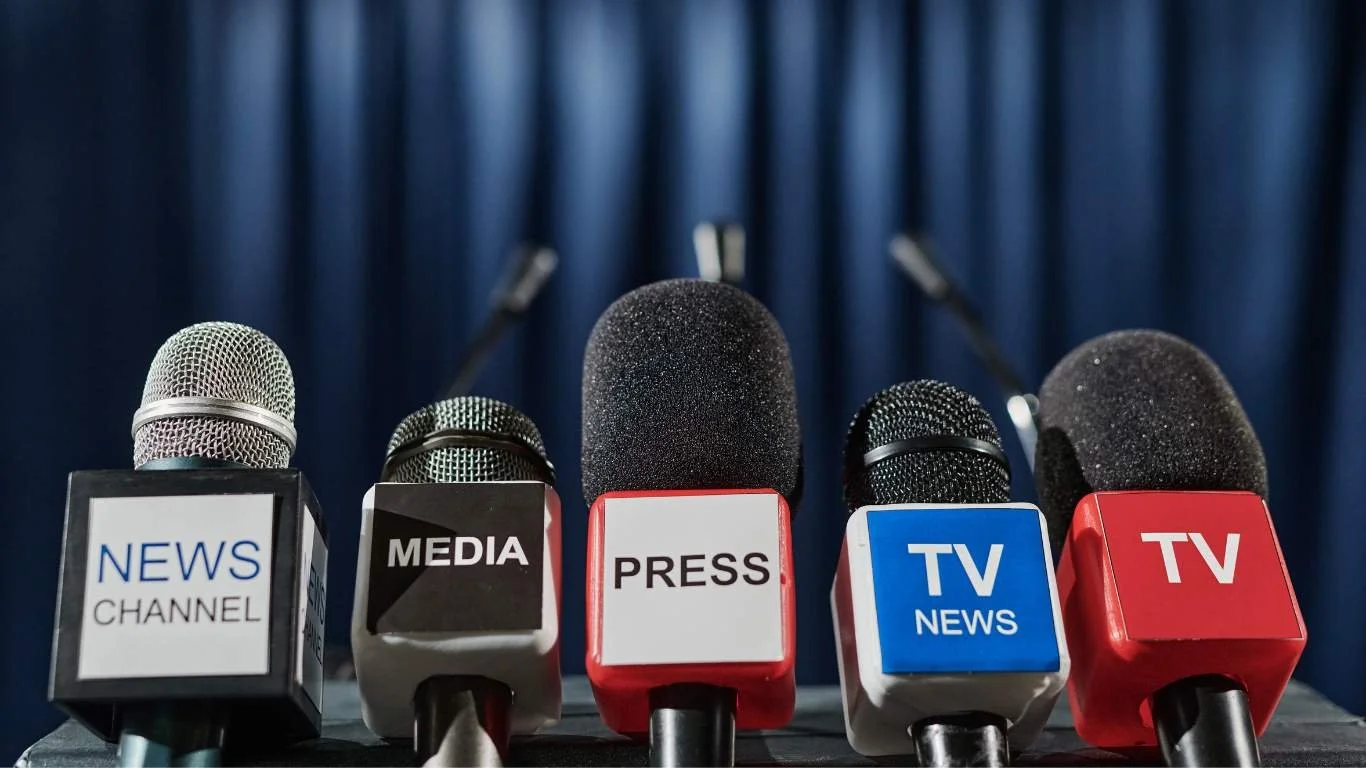Expert Tips on How to Contact Media for Help With Your Story
Need media coverage for your story? Simplify the process with our expert guidance on how to contact media for help. Discover the right channels, perfect your pitch, and forge relationships with journalists for impactful storytelling. Unlock the potential of media outreach starting now.
Key Takeaways
Identify the right media channels for your story by assessing brand compatibility, audience demographics, and utilizing tools like Google News to find relevant journalists covering your topics; consider local news, national platforms, and specialized press for different levels of reach.
Craft compelling pitches with clear, impactful headlines, unique angles, and timeliness to capture media attention; use multimedia elements to enhance appeal and ensure pitches emphasize why the story matters right now.
Build relationships with journalists through engagement on social media, networking at media events, and professional follow-ups; utilize tools like media databases and email discovery services to find contact information and exercise good follow-up etiquette to stay on their radar.
Decoding the Media Landscape: Identifying the Right Channels
Navigating the media landscape can be a complex task. Media channels are diverse, each having unique content requirements and audience engagement strategies. To effectively tell your story, a tailored approach that considers these factors is crucial. But how do you choose the right channel? The key is in assessing the compatibility of the channel with your brand narrative and its capabilities for audience building.
Different media outlets cater to different audience demographics. Therefore, understanding the reach of your story and the demographics of the media outlets is vital for maximum impact. In this digital era, tools like Google News come in handy. They help discover media outlets that align with your specific keywords, making it easier to target and connect with journalists covering relevant topics.
Now, let’s delve deeper into the types of media outlets you can leverage: local news outlets, national platforms, and specialized press. Each has its unique advantages and can be instrumental in getting your story heard.
Local News Outlets – Your First Stop
Starting locally has its perks. Local news outlets wield significant influence within their communities and can provide a strong foundation for your story. Finding interested reporters and outlets is as simple as:
Reading local papers
Listening to local radio
Watching local news broadcasts
Performing internet searches.
One effective strategy for a school district is meeting with editorial boards. Such meetings can influence newspaper editorials and garner support for your cause. As a result, you can build relationships with local journalists, increase media coverage, and gain community support. Remember, every global story begins somewhere local.
National Platforms for Broader Reach
While local news outlets can provide an excellent starting point, expanding your reach to national platforms can take your story to the next level. Building a list of national outlets suitable for your story is an essential step towards increasing its reach. Tools like Cision can help you find the right national journalists. National media exposure can make your story go viral, influencing public opinion and policymakers at a larger scale.
However, it’s worth noting that national outlets may have specific pitch requirements and preferences. So, do your research and adhere to these requirements. Services like PR Newswire provide distribution networks that can help publish your story across numerous national platforms simultaneously, further extending your reach.
Specialized Press for Niche Stories
For stories with a specific focus, the specialized press can be a goldmine. Journalists covering industry-specific stories are always on the lookout for fresh, relevant content. Tools like backlink checkers, such as Semrush, can help trace publications that link to websites related to your niche, leading you to these journalists.
This focused approach not only increases your chances of press coverage but also ensures your story reaches the most relevant audience.
Crafting a Compelling Pitch to Capture Media Attention
Having identified the right media outlets, it’s time to craft a compelling pitch. A pitch is your story’s ticket to the media stage. It should not only catch a reporter’s eye but also leave some information to be discovered in the story itself. This involves summarizing your story, highlighting its unique angle, and differentiating it from seemingly similar stories.
Moreover, it’s crucial to convey the urgency and relevance of your story. Explain why the story matters now and what the implications or benefits are of publishing it immediately. Now, let’s break down the aspects of crafting a compelling pitch: creating an irresistible headline, presenting a unique angle, and emphasizing the story’s timeliness.
The Hook: Creating an Irresistible Headline
A headline is the first thing a journalist sees – it’s your story’s hook. An effective headline should:
Be clear, simple, and understood by diverse audiences
Be true and memorable
Prioritize immediate engagement
Distill the ‘5 Ws’ (who, what, when, where, why) into a headline that catches a reporter’s eye while still leaving some information to be discovered in the story itself.
Emotional words or phrases that pique curiosity can significantly enhance a headline’s click-through rate, especially when presenting solutions to problems. Making the ‘so what’ factor clear in the headline ensures its value is immediately recognized. Using active language or humor can effectively leave a strong first impression.
The Heart of the Story: Your Unique Angle
A unique angle is the heart of your story. It helps journalists quickly grasp why the story matters and stands out. Identifying your target audience can guide you in tailoring the story’s angle to match their interests, ensuring that the story resonates effectively.
The chosen angle directly influences how you present the facts and sources, aiming to engage and captivate the intended readership. Incorporating multimedia elements, such as photos and videos, can significantly enhance the attractiveness of a story to journalists and their audiences. An editor plays a crucial role in refining the final piece for publication.
Timing is Everything: Why Your Story Matters Now
Timing plays a vital role in the success of your pitch. Timely narratives can enhance the appeal of your pitch to journalists. Journalists are more likely to engage with stories that reflect current trends and events. Integrating these trends into your pitch can position you as a valuable resource to journalists.
A pitch that is seen as urgent and relevant is more likely to be picked up by media outlets. So, it’s crucial to highlight why your story matters now and what the implications or benefits are of publishing it immediately.
Building Relationships with Journalists and Reporters
Creating a compelling pitch is only part of the game. Building relationships with journalists can significantly enhance your chances of getting your story heard. This involves:
Researching their past work
Respecting their time
Providing valuable contributions to their reporting
Offering journalists a list of potential stories in advance
These actions can aid in managing their schedules and strengthen the strategic partnership.
Now, how do you build these relationships? It’s all about engagement – on social media, at media events, and through professional follow-ups. Let’s explore each of these strategies.
Engaging on Social Media Platforms
Social media platforms have become a strategic arena for building professional relationships with journalists. However, your approach should be tailored and respectful to their preferences and boundaries. Many journalists include their contact information on their social media profiles, providing alternative access to their contact details.
Direct messaging on social media platforms can be used for:
Politely requesting a journalist’s email address when not publicly available
Finding journalists
Engaging with journalists
Building relationships with journalists
Staying updated on journalists’ latest stories
Networking at Media Events
Media events offer a golden opportunity to meet journalists in person and establish more personal and lasting connections. Before attending, research the event and its participants to identify the companies and representatives you want to meet.
Employ strategies to stand out, such as:
Having a unique business card or calling card
Approaching open conversations
Maintaining eye contact
Engaging in meaningful conversations
Remember, a confident handshake and genuine interest can foster connections and leave a lasting impression.
Follow-up Etiquette: Staying on Journalists' Radar
Follow-ups are crucial in maintaining contact with reporters after pitching a story. Journalists typically prefer to be followed up with via email rather than phone calls, which can be perceived as too aggressive and intrusive. Follow-ups should demonstrate persistence yet be courteous, aiming to maintain a professional relationship without coming across as overbearing.
Sending a second or third email after the initial pitch is important. However, if necessary, delaying follow-up can be preferable to avoid appearing desperate or pushy. On the third follow-up, leaving contact information and relevant materials can help keep the channels of communication open for future story opportunities.
Utilizing Tools and Resources to Find Journalist Contacts
In the digital age, various tools and resources can assist in finding journalists’ contacts and help identify journalists. Media databases like Prowly, Press Hunt, and Anewstip are instrumental in locating journalists and their contact information. These databases can be filtered by criteria such as beat, location, and outlet, which helps in finding the most relevant journalists for a particular story or industry.
However, media databases are not the only tools at your disposal. Email discovery services and website searches can also be effective in finding journalist contacts. Let’s explore these two types of tools.
Email Discovery Services: Finding the Right Addresses
Email discovery services like Hunter and Voila Norbert are dedicated tools designed to assist users in finding journalists’ e mail addresses. While they may not offer the same level of accuracy as a media database, email finder tools can provide a quick method to identify a journalist’s email.
These services can be particularly useful when you need to find journalists and have identified the journalist but can’t find their contact information on media databases or social media platforms. Remember, having the right contact information is the first step towards getting your story heard and being able to contact journalists effectively.
Media Databases: A Wealth of Contact Information
Media databases are a treasure trove of journalist contact information. They provide a directory of various national or international media contacts that can be filtered by beat, location, outlet, and include bloggers and other digital influencers. These databases reveal recent articles by journalists, their social media profiles, and additional background information, which is valuable for understanding their interests and reporting style.
Some advanced media databases, like Prowly’s, offer access to over a million contacts. They can provide tailored recommendations for contact based on the contents of a press release. This wealth of contact information can be a game-changer in getting your story heard.
The Art of the Follow-Up: Ensuring Your Story Gets Heard
Mastering the art of follow-up is key to ensuring your story gets heard. Employing strategic timing for follow-ups after sending your media pitch can significantly enhance your chances of getting a response. A practical guideline is to wait for about three days after the initial media pitch before sending a follow-up email. However, limit follow-up attempts to two additional emails beyond the original pitch to maintain professionalism and avoid being perceived as spam.
So, how do you ensure your follow-ups are effective? It’s about timing, handling rejection gracefully, and learning from successful examples. Let’s unravel these strategies.
The Gentle Nudge: When and How to Follow Up
When time is of the essence, a gentle nudge can make all the difference. Allow at least two to three days after your initial pitch before sending a follow-up email to give journalists sufficient time to process the information. When sending follow-up communications, it is best to do so during the journalists’ most active hours, typically between 8:00 a.m. to 12:00 p.m..
Ensure that the follow-up email is professional and polite, clearly articulates the news value, and expresses readiness to provide more details. Personalize follow-up email templates to remind journalists of the initial pitch and your availability to discuss the story further. After two follow-up attempts without a response, consider refraining from further follow-up on the same topic to prevent being seen as spam.
Finally, send a courteous closure email, stating that it will be the last attempt regarding the current topic while keeping the door open for future stories.
Handling Rejection: What to Do If They're Not Interested
Rejection is part of the process. When facing rejection from media contacts, it is crucial to remain professional at all times. Always thank the journalist for their time, indicating respect for their work and decision.
Leaving your contact information is important as it facilitates future communication should opportunities arise. Expressing a willingness to submit future pitches can help sustain a relationship with the journalist for potential collaboration later on. Remember, today’s ‘No’ could be tomorrow’s ‘Yes.’
Success Stories: Examples of Effective Follow-Ups
Sometimes, success lies in persistence. Key Club highlights the importance of maintaining contact with reporters after pitching a story, emphasizing that consistent follow-ups demonstrate professionalism and can open doors to future media coverage opportunities. One of the key points to remember is the significance of persistence in communication.
This example should inspire you to stay persistent and patient, knowing that your efforts will eventually pay off.
Summary
Navigating the media landscape, crafting compelling pitches, building relationships with journalists, and mastering the art of follow-up are all integral parts of getting your story heard. With the right strategies, tools, and a dash of persistence, you can break through the noise and capture the media’s attention. Remember, every story is worth telling, and every voice, including yours, matters.
Curious to learn more about how Salient PR can elevate your public relations? Visit our website to explore our services and success stories.
Frequently Asked Questions
How do I contact news media with a story?
You can contact news media with your story by using the email or phone number provided by the news organization for story tips. Some publications also list their contact information inside the publication.
How do I choose the right media outlets for my story?
To choose the right media outlets for your story, consider the audience demographics, assess compatibility with your brand narrative, and use tools like Google News to find outlets that align with your specific keywords. This will help ensure that your story reaches the most relevant audience and is aligned with your brand's messaging.
How can I create an irresistible headline for my pitch?
To create an irresistible headline for your pitch, distill the '5 Ws' into a catchy and clear statement that piques curiosity with emotional words or phrases. This will catch a reporter's eye and make your pitch stand out.
How can I build relationships with journalists?
To build relationships with journalists, research their past work, engage with them on social media, network at media events, and follow up professionally. These steps can help you establish connections and rapport with journalists.
How do I find journalists' contacts?
To find journalists' contacts, you can use media databases like Prowly, Press Hunt, and Anewstip, or email discovery services like Hunter and Voila Norbert. Another option is to check media websites in the 'contact us' or 'about us' sections.







